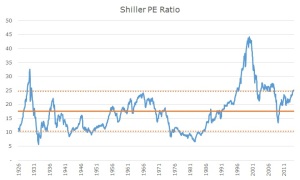Fundamental Analysis:
Fundamental analysis is an approach used by some stock traders and stock market analysts to determine the valuation of a company or the stock market. This is considered an important element in an analysts’ decision-making process as it is believed that such information can discern whether a stock or stock market is under or over-valued.
A recent webinar that I held in October 2014, titled “Using Fundamental Analysis in Stock Market Trading – Beta, P/E Ratio, Tobin’s q and More”, used Tesco and Facebook as a case study to determine whether these stocks would be considered a buying, selling or shorting opportunity. Fundamental analysis examined during this Tesco and Facebook case study were the price-earnings ratio, earnings per share, Tobin’s q, beta and some financial ratios.
Price-Earnings Ratio:

Source: Robert J. Shiller
The price-earnings ratio, or PE ratio for short, is a common value indicator, where a company’s share price is divided by its earnings per share (EPS). The PE ratio informs the investor of the number of years it will take to return each dollar invested, or alternatively it signals to the market the number of dollars an investor is willing to pay for $1 of earnings.
The PE ratio is found to have a historical average of approximately 16. Therefore, any number above this would be considered an over-valuation, while a number less than this is an under-valuation. However, problems arise if a company has negative earnings (the PE can only be interpreted when positive) or where the EPS is so small or almost zero (the PE becomes so large and irrelevant).
Robert J. Shiller and CAPE:
Yale economist and Nobel Laureate, Robert J. Shiller, developed the cyclically-adjusted PE [CAPE] to counter these problems by averaging 10 quarterly earnings. The possibility of a negative eps is removed. Shiller found the CAPE to average 17.5 over the period 1926 to 2014 for the S&P500 (see diagram 1 below). CAPE was approximately 45 in 2001, which hugely over-valued the stock market , resulting in a stock market crash (see diagram 2). Shiller had warned of this impending crash for a number of years leading to this crash. This highlights another notable weakness of the PE ratio – it is not considered a good timing device, i.e. the ratio will fail to inform the trader of the optimal time to exit or enter the trade.
Tesco’s PE Ratio
Using advfn.com initially, it was found that the stock price of Tesco was 171 pence and its EPS was 12.07 pence, resulting in a PE ratio of 14.17. This is quite a reasonable number and shouldn’t be of any concern. However, events unfolded recently whereby Tesco failed to give an accurate account of its earnings and failed to inform investors of its performance. A look at Yahoo Finance seems to give an updated version of events, quoting the EPS at 0.12 pence – a significant difference to the 12.07 pence quoted by advfn.com. Based on the price of 171 pence, the PE ratio is 1413.22 (1425 based on my own calculations). This is way too high, and in order for the PE ratio to reflect the historical benchmark of 17.5, Tesco shares must collapse to 2.1 pence – a penny stock – to reflect the low EPS of 0.12 pence! Alternatively, the EPS must increase significantly to reflect the ‘justified’ price of 171 pence. This, however, is unlikely and, subsequently, the PE ratio becomes inconsequential and unreliable.
Facebook’s PE Ratio
Again, using advfn.com, Facebook’s PE ratio is an astonishing 124.1 based on the EPS of 0.62 cents and a share price of $80.18 (the PE ratio is found to be 129.32, but there may have been a time delay in updating the PE on advfn). Again, like our PE analysis of Tesco above, Facebook’ PE ratio is somewhat different to that quoted by Yahoo Finance. Based on an EPS of 0.94 and a share price of $80.04, the PE ratio is found to be 85.14, again indicating an over-valued company in terms of its stock price. Are investors willing to pay $85 for every $1 earned by Facebook? Not me! So, according to this valuation measure, Facebook is a sell. But remember, the PE ratio is not a good timing device, so shares could continue to increase for some time to come.
Confusion Over Differences in PE Ratios for the Same Stock
You may have noticed differences in the PE ratio as quoted by advfn.com and by Yahoo Finance. Ultimately, this boils down to the EPS quoted by each, since the stock price is commonly quoted. There is confusion as to what type of earnings a company should declare when releasing its results – GAAP or non-GAAP earnings? Likewise, there are differences in how analysts use earnings. Some quote actual earnings while others quote expected future earnings. There is no standard, and perhaps the SEC and others should create a standard practice.
Tobin’s q
Tobin’s q, another valuation measure, was developed by the late Nobel Laureate James Tobin, also another Yale economist. He hypothesised that the market value of a stock should be equal to the replacement value of its assets, i.e. the stock price multiplied by the shares issues (i.e. market capitalisation) should have the same value as the assets of that company. Therefore, Tobin’s q has a theoretical value of 1.0 and any q value above this would indicate the stock price to be too high relative to the company’s assets. Consequently, the share price should fall until the q ratio reverts back to unity. A q ratio below 1.0 indicates an under-valued company in terms of its market value, or more specifically, its share price. The stock price should rise as a result.
Again, using advfn.com, the Tobin’s q ratio for Tesco is 0.28. This is significantly low, suggesting that the company is considerably under-valued. The replacement value of Tesco’s assets are more than the market value of the company. In conclusion, based on this observation, Tesco’s recent share price plunge is unjustified. If Tesco were to sell off all its assets – both tangible and intangible – it would receive more that its market value as reflected in the share price of 171 pence.
PE Ratio and Tobin’s q for Tesco Are Incoherent
 It appears that both ratios are giving a conflicting message – the PE ratio of 1413.22 is over-valuing the company, whereas Tobin’s q is under-valuing the company. During the webinar (7:07 minutes into the discussion), I highlighted that both the PE ratio and Tobin’s q are correlated, meaning that they would typically be agreeable in terms of their conclusion. However, due to this disjointed interpretation and conclusion about whether Tesco should be a sell or short (according to the PE ratio) or a buy (according to Tobin’s q), it may be wise to consider other fundamentals such as the dividend yield, the beta coefficient and some financial ratios.
It appears that both ratios are giving a conflicting message – the PE ratio of 1413.22 is over-valuing the company, whereas Tobin’s q is under-valuing the company. During the webinar (7:07 minutes into the discussion), I highlighted that both the PE ratio and Tobin’s q are correlated, meaning that they would typically be agreeable in terms of their conclusion. However, due to this disjointed interpretation and conclusion about whether Tesco should be a sell or short (according to the PE ratio) or a buy (according to Tobin’s q), it may be wise to consider other fundamentals such as the dividend yield, the beta coefficient and some financial ratios.
Understanding Facebook’s Tobin’s q
Facebook’s Tobin q is quoted at 11.43, indicating that the company is significantly over-valued. This confirms the PE over-valuation. The q of 11.43 suggests that the market value of Facebook far exceeds the replacement cost of its assets, i.e. if Facebook were to sell off its assets today, it would fail to match the market capitalisation of the firm. Facebook, being a tech company, does not have the physical or tangible assets of other companies like Tesco or Ford. However, the market values Facebook more than these and many other companies. Is the price of Facebook sustainable? According to Tobin’s q – No. However, further analysis of financial ratios indicate that Facebook is cash rich and is a low geared company. This is the complete opposite to Tesco.
Dividend Yield
The dividend yield is the amount of cash flow the investor receives from a company for every dollar invested in that company’s stock. Tesco pays a dividend but Facebook does not. It can be argued that a company should retain its earnings and use the cash flow to invest in current and future projects. This will benefit the company and long-term investors as there is a growth and expansion expectation for the company, which may correlate with stock price appreciation. Investors, particularly value investors, prefer to invest in high dividend yielding stocks as they receive a return plus a possible equity gain.
Tesco Pays a Dividend But Facebook Does Not
Tesco paid an annual dividend yield of 8.63% based on the previous fiscal year dividends of 14.83 pence and the current share price of 171 pence (14.83/171). This appears to be a high yielding stock and great news for investors. However, since the tumultuous turn of events recently, interim dividends on October 23, are 1.16 pence – down from the previous interim dividend of 4.63 pence. As a crude estimation for full year dividend payments (in order to estimate the yield, I have assumed a final dividend of approximately 3 pence, resulting in a yield of 2.4% (total dividend of 4.16 divided by current share price). This seems realistic than the 8.63% yield. Since Facebook does not pay a dividend, it may be difficult to justify a buy or sell recommendation. It is not uncommon for company’s not to pay a dividend.
Beta
The beta of a stock signals the risk potential of the stock relative to the overall stock market. It is typically used by analysts or investors to match the risk profile of an investor with a stock. For example, traders and investors are not homogenous and their risk profiles differ. Some are risk averse, while others are more risk tolerant. Typically, the beta of a stock market or a large portfolio of shares has a value of 1.0. A company that has a beta below 1.0 is considered less risky and would suit risk averse investors, while a beta greater than 1.0 is a riskier investment. For example, a company with a beta of 1.4 will, on average, return 1.4% if the market returns 1.0%. The beta coefficient can be calculated by means of regression analysis, something I will demonstrate in the near future. The one criticism that I have about the beta coefficient is that it is based on historical data and is not indicative of the future risk profile of the company.
Tesco and Facebook are Low-Risk According to Their Beta
Tesco’s beta is 0.74 according to advfn.com, which indicates that Tesco is a low-risk investment (but N/A on Yahoo Finance). However, recent events has shown otherwise, hence my criticsm. Facebook’s beta is 0.8 on Yahoo Finance also indicating a relative low-risk investment. Given th e high PE value for Facebook, I certainly would believe that this company is over-valued and I am personally surprised by its low beta value.
e high PE value for Facebook, I certainly would believe that this company is over-valued and I am personally surprised by its low beta value.
I speculate that the share price of Facebook has remained quite vigilant during recent stock market volatility. This is possibly due to the large shareholding that CEO and founder Mark Zuckerberg has, as well as the possible emotional attachment or herding behavior that some shareholders have in retaining their shares. This may have liquidity effects on share volume, as well as having net buyers in the market. This results in more stability in prices relative to the market or a continuation in share price increases. Confusing, right? But remember, I do speculate in explaining why Facebook’s PE is high but it’s share price continues to defy this over-valuation.
Financial Ratios
In the webinar, I briefly reviewed some common financial ratios for both companies, namely the current ratio and the acid test ratio. A company is considered to have a healthy balance sheet if its Current ratio has a value of 2:1 and an Acid Test Ratio of 1:1, meaning that its assets can cover its liabilities. Tesco, however, has an extremely worrying Current Ratio of 0.84, whereas Facebook has an almost unheard of Current Ratio of 11.8. Likewise, the Acid Test Ratio for both are 0.7 and 10.4. Tesco is considered an ‘unhealthy’ company, while Facebook has assets that more than covers its liabilities. Based on this alone, Tesco is a sell recommendation but Facebook should make its current investors quite happy.
A bar chart summarising Tesco’s Balance Sheet can be found at 11 minutes and 52 seconds into the webinar, while the same can be found for Facebook at 43 minutes and 26 seconds into the webinar. The ‘yellow’ shaded area in both bar charts indicate ‘Total Equity’ (on the left) and ‘Cash & Equivalents’ (on the right). Both companies significantly differ. Tesco’s ‘yellow’ areas are dwarfed by those of Facebook, meaning that Tesco is a highly geared company (more debt) and has very little cash, which is tied up in its fixed assets, debtors and stock. This is the nature of the type of business that Tesco finds itself in – it needs physical stores to sell its stock whereas Facebook’s business model is an online presence. Tobin’s q valuation of both companies could possibly be justified based on the assets of both companies.
Summary
On reflection, Tesco is a troubled company and its expansion plans into the Far East, as well as new markets such as insurance, telecoms and personal finance may have cost them dearly. They have lost market share in the retail space to German chains Aldi and Lidl. To meet debt obligations and fund current activities, Tesco may have to sell off some of its assets or perhaps a business arm, such as its banking operations. Since the market is undervaluing its shares according to Tobin’s q, this perhaps is a viable time to sell. The PE ratio can, in this case, be ignored and an investor looking to Tesco’s beta for an indication of a ‘safe bet’ can also ignore it as it places too much emphasis on historical returns relative to the market.
A question posed by an attendee during this webinar, Cristina Chase, asked if Warren Buffet had an effect on the current share price of Tesco due to his announcement of share selling. Reviewing the charts for Tesco, it was noted that the stock ‘gapped’ downward on two occasions possbly coinciding with his sell-off.
Another attendee, Lee Rock asked were Tesco and Facebook a buy or sell. To answer this, I reviewed the price chart patterns of both (technical analysis) to support the claims of the fundamental analysis discussed above. Tesco, has been trending downward since October 2013 but currently I noticed a double bottom formation at the 171 pence level for October 23, 2014. This double or, possibly, triple bottom could signal a reversal of the trend, particularly when the relative strength index is rising (for more on this and other technical trading indicators, please click here).
These indicators, together with Tobin’s q, suggest a buying opportunity. However, caution beckons in the near-term future for Tesco in dealing with the headwinds it faces. Regarding Facebook, the technical indicators is showing a drop in the price into a new trending pattern. The price of $80 is a critical resistance level and if Facebook fails to break above and settle above this level then the price could fall further. Both the PE ratio and Tobin’s q indicate an over-valuation of Facebook, therefore a sell recommendation. However, as stated above, Facebook is cash-rich and, coupled with the large equity holding of a few key personnel, the stock price may be supported at this high price.
If you would like to comment below, I would really appreciate it. Let me know of your opinions and suggestions and I will respond. For more posts like this, please visit www.economicrockstar.com or subscribe to our podcast on iTunes.
 024: Greg Davies on Behavioral Finance and Controlling Your Emotions When Making Trading Decisions
024: Greg Davies on Behavioral Finance and Controlling Your Emotions When Making Trading Decisions 056: Campbell Harvey on Improving Significance Tests, the Importance of Positive Skew and the Future of Blockchain
056: Campbell Harvey on Improving Significance Tests, the Importance of Positive Skew and the Future of Blockchain 001: Jason Stapleton on Technical Trading Systems and Losing Everything on Penny Stocks
001: Jason Stapleton on Technical Trading Systems and Losing Everything on Penny Stocks 165: Stephen Wright on Valuing the Stock Market Using Equity q
165: Stephen Wright on Valuing the Stock Market Using Equity q 002: Jason Stapleton on Trader Psychology and Why You Shouldn’t Listen to Financial News
002: Jason Stapleton on Trader Psychology and Why You Shouldn’t Listen to Financial News Protected: Bitcoins as Discussed by Bitcoin Girl, Naomi Brockwell, in Episode 009
Protected: Bitcoins as Discussed by Bitcoin Girl, Naomi Brockwell, in Episode 009 Conor McGregor is Homo Economicus: I’m Going To Whoop His Ass
Conor McGregor is Homo Economicus: I’m Going To Whoop His Ass Economic Rockstar Guests on TED
Economic Rockstar Guests on TED How to Calculate Statistics Using Excel
How to Calculate Statistics Using Excel How to set up your Blog in minutes with Bluehost!
How to set up your Blog in minutes with Bluehost!
 Faith Okello 20066557
Faith Okello 20066557
November 2, 2014 at 10:41 pmI have found this article very useful in understanding the different approaches to stock market analysis particularly when comparing the two companies.
Thank you
 Frank
Frank
November 2, 2014 at 11:08 pmThanks for the comment Faith. If there’s anything that you would like me to write about, just let me know.
 Ankit Garg Shukla 20065213
Ankit Garg Shukla 20065213
November 3, 2014 at 2:17 amSplits: 6 Jul 1987 [2:1], 6 Jul 1998 [3:1]
Tesco PLC (TSCO.L)-LSE Ticker: 884709 / ISIN: GB0008847096
P/E (ttm): 8,680.00
EPS (ttm): 0.02
Div & Yield: N/A (N/A)
Currency in GBp.
Hi frank,
This data is from Yahoo(finance). In your above description you have written that P/E is 1425 according to your calculation but here it is 8680 and EPS is 0.02 and yours is 0.12.
My question is that Why there is two different data in advfn and in yahoo finance??? on which one we should believe???
 Frank
Frank
November 3, 2014 at 10:11 pmHi Ankit. The eps has changed since the post has been written and, as a result, the P/E has been updated by you to reflect this change. My figure of 1425 is based on the 23rd October 2014 information. The reason why there are two different PE ratios on advfn.com and Yahoo Finance is that they are using different eps figures. The stock prices are the same, so the difference is reflected in the use of eps. Unfortunately, there is no national, let alone international, accounting standard set for the use of earnings to reflect a companies performance. Personally, I believe that this should be tackled to avoid confusion. Some analysts use current earnings, while others use future or expected earnings. Then there is the issue of using GAAP and non-GAAP earnings. Confused, right? Me too, but we must keep a watchful eye on the source of earnings being used by analysts. Thanks for a great question Ankit.
 Ankit Garg Shukla 20065213
Ankit Garg Shukla 20065213
November 6, 2014 at 2:56 pmHi Frank,
Thanks for your reply.
And yes confuse but no worries will do some research on that.
 Natalia Zosim 20033299
Natalia Zosim 20033299
November 16, 2014 at 1:24 amHi Frank,
Was working under my Stocktrak report and decided to read carefully your article. Thank you very much for such a good explanation and clarification of the fundamental analysis, as was very valuable and appropriate for completion of my Stocktrak report.
Thank you.
 Frank
Frank
November 16, 2014 at 10:43 amThanks Natalia. I’m glad the article was of some help to you. Thanks for taking time out to read it.